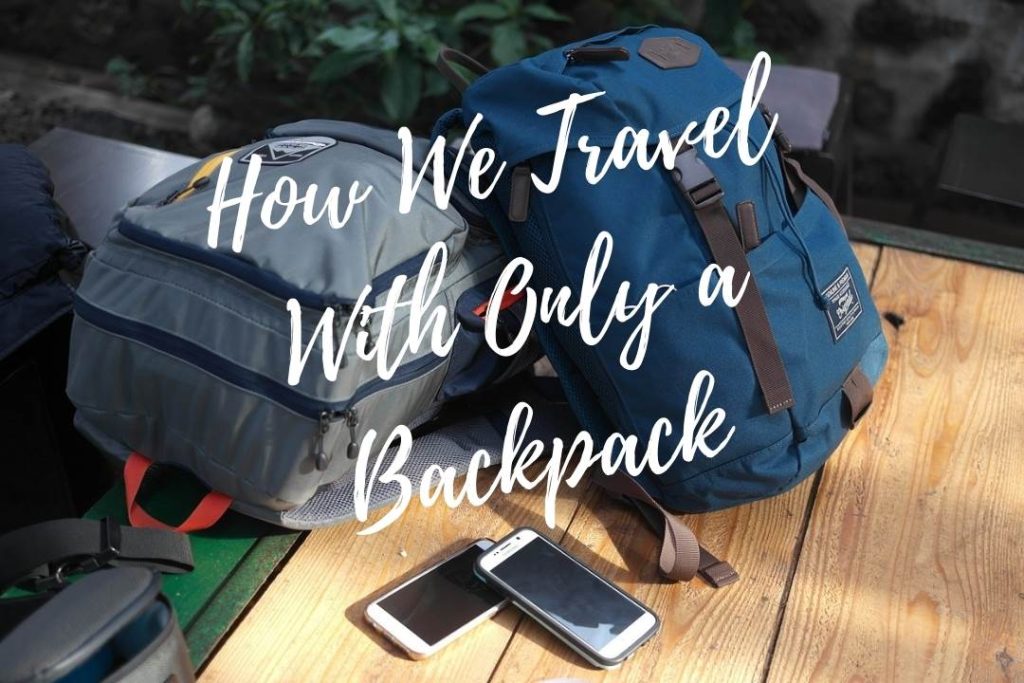Travel With Just a Backpack
You know the drill. About 40 minutes before your flight, one of the flight attendants announces that the flight is full and they need volunteers to check bags. Once again, passengers find themselves pitted against one another in a Hunger Games-like quest to get their bags into the overhead bins as quickly as possible.
A low-key frenzy begins as travelers start to line up to board the plane, each person jockeying to get on as fast as possible and secure the ever-elusive overhead storage. The idea of checking bags sets off that instinctual fear that if you’re among the unlucky ones to check a bag, it might not arrive at your destination – and then what? In my experience, skipping all that chaos to travel with a backpack is best.
Why I Ditched My Traditional Carry-on Bag

Having plenty of clothing options and amenities from home can be a great way to travel comfortably, but traveling with traditional luggage can cause unnecessary travel challenges. The obvious, and typically most common, issue is that checked bags sometimes arrive late to the intended destination, so people are eager to use the plane’s overhead storage. The more people using that storage, the greater the likelihood of running out of space, especially knowing that some folks exceed the size guidelines.
Generally, when I land, I need all the stuff in my bag; I can’t risk a lost or delayed bag. Over the years, the stress of boarding the plane as fast as possible – to score some precious overhead space – wore me down. It’s annoying and tiresome standing at attention and strategically trying to inch ahead of other passengers during the boarding process. Once I switched to traveling with a backpack instead of a traditional wheeled carry-on bag, flying became far less stressful.
The Mishandled Baggage Data Validates Your Fears
Here’s the thing. Expert advice for hassle-free travel typically includes tips on carry-on bag strategies and with good reason. Although the airline industry has improved over the last 15 years, SITA, an air transport technology group, reports that 26 million mishandled bags were logged across a total of 3.42 billion passengers in 2022.
Realistically, knowing that only 7% of bags were lost or stolen isn’t all that reassuring, considering that 80% were delayed. Delayed luggage is a major issue whether you’re traveling for work or pleasure. It requires a lot of time and energy to rectify and is often costly because you may need to buy clothing or supplies.
Travel With a Backpack- It Fits in a Crowded Overhead Storage Bin
Instead of a wheelie bag, opt for a backpack designed for traveling, which is often about 28 – 32 L in capacity. At this size, it’s likely that – even in a nearly full overhead bin – it might fit in between or on top of other luggage. The fact that it’s a soft-sided bag also allows wiggle room for making it fit – i.e., smooshing it in a small space, if necessary. You can’t do that with a firm-sided carry-on bag with a pre-determined rectangular or square shape.
When All Else Fails, a Backpack Will Fit Under The Seat in Front of You
Most of the time, I can squeeze my backpack into an overhead bin, but the fact that – in a pinch – it will fit under the seat in front of me gives me peace of mind. Although under-the-seat storage capacity varies between the major airlines, the difference is usually just a few inches. And since this scenario is my backup plan, I know I can make it work as a last resort. That might, again, require a little bit of squishing of the outermost areas of the back to wedge it in there, but it’ll work just fine when you’re in a jam.
Choose The Right Size Travel Backpack
It’s easy to hedge your bets when choosing a carry-on backpack. For example, American Airlines’ personal item policy, which dictates the under-seat storage limitations, indicates the maximum size is 18 x 14 x 8 inches, similar to many others. But some airlines have a smaller space, such as United, which usually has a max capacity of 9 x 10 x 17 inches.
Again, these guidelines will vary depending on the airline and the aircraft size; a small puddle-jumper will have far less capacity than a mammoth international flight. With this in mind, I keep my travel backpack around 18 inches long, 11 inches wide, and 9 inches tall. I’ve been using the Thule Aion 28 L backpack for a year, and its size and organizational compartments have never failed me.
Embrace a Minimalist Approach To Packing
Along the way, I’ve learned that a minimalist approach to packing requires little sacrifice. I am a master packer and like to have plenty of just-in-case items packed for any trip. As a first step, I use a capsule approach to packing clothes to make the backpack approach viable. I choose a few colors that mix and match well, and I’m okay with repeat wearings.
Here’s how this works. For example, I have an olive-colored top that goes well with a few bottoms I’ve packed. I’ll first wear the top to a short-duration outing – like dinner. Then, knowing I’ve clocked only a few hours of wear, I’ll wear it again for a full day of travel activities. Strategically, I’ll do this a day or two later in the trip, which keeps my outfits looking different from one day to the next. Doing this can significantly reduce your overall volume of packed clothing.
Here’s The Cheap and Easy Way To Pack a Lot of Toiletries
I’m the traveler who packs with a “what if” mentality; what if my allergies flare up or I get indigestion? This proactive thinking can ensure smooth, comfortable travels. It can also take up a lot of space in your travel backpack. One of the ways to conserve space is to remove excess packaging. The allergy medicine doesn’t need to stay in the box. Instead, I made a one-time purchase of assorted-size zipper-top plastic bags for less than $15.
At any given time, my travel backpack has a one-gallon size zipper bag, and in that, I store multiple small bags with everything from antacids to ibuprofen and Airborne tablets. One of my go-to helpful travel tips is that everything comes out of the original packaging – including any pull-open plastic encasements. Each itty-bitty bag is labeled with a sharpie, and the entire thing remains light, flat, and manageable.
Extra Air in Your Travel Backpack Is Your Greatest Challenge
Removing the additional packaging from toiletries eliminates unnecessary air pockets in your bag – wasted packing real estate. Take this philosophy a step further and think about air trapped within the clothes you pack. Packing cubes are helpful for organization, but most do not help save space.
Compression bags are a great solution but look for bags that don’t require a handheld device that sucks the air out. Instead, look for compression bags that allow a one-way air release when rolled. I use the roll-up style storage in this compression bag set, which has traditional vacuum-style compression bags and ones that can be rolled by hand.
Just slide your neatly folded clothes inside, seal the bag’s zipper 95% of the way, and roll it up while applying downward pressure. Once fully compressed, finish closing the zipper; this process usually reduces the size of the clothing package by 50-60%, in my experience.
Organize Your Carry-on Backpack for Efficiency
Another helpful strategy to make the switch from a traditional carry-on bag to a travel backpack involves organization. By default, the tips up to now – a backpack with suitable compartments, reducing packaging, and compressing out excess air – will all help with efficiency. In addition to these methods, I pack to maximize the flexibility of the bag’s exterior (to help me cram it into small spaces) and the ease of accessing its contents.
Having clothing in the compression bags means I don’t have to awkwardly dig through folded clothes to find what I might need while en route to my destination. Among the priorities, easy access to my laptop and other security-related items tops the list.
Think About What Items You Might Need to Access
From there, the items I will most likely need in an airport or on a flight are closest to the bag’s opening at the top — a book or light sweater. If you’re a fan of crossword puzzles, you can rip a few out of the book to save packing space. Whatever you do, though, avoid having firm items like shoes too close to the outermost area of the pack; this reduces your ability to squish the backpack’s sides enough to fit into a small space.




